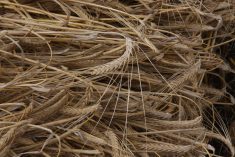Farmers probably won’t plant much brown or oriental mustard this year.
Prices are low and growing conditions are bad, says Agriculture Canada special crops analyst Stan Skrypetz.
“I think it’s a combination of price and dryness,” said Skrypetz, explaining the 40 percent drop in mustard acreage that Statistics Canada expects. Agriculture Canada estimates the 2001 crop will be only 120,000 tonnes.
Stats Can’s seeding intentions report doesn’t differentiate between yellow, brown and oriental mustard, but Skrypetz said the latter two will probably make up most of the acreage drop while yellow will hang on.
Read Also

Vegetable oil stocks are expected to tighten this year
Global vegetable oil stocks are forecast to tighten in the 2025-26 crop year, this should bode well for canola demand.
Prices for yellow mustard are better, with bids of up to 19 cents a pound. Brown and oriental mustard are bringing bids of only 11 to 12 cents. Yellow mustard generally sells for more per bushel, but yields less.
However, this year the spread between the varieties makes yellow more valuable. Yellow acres will be almost half of all mustard, while 33 percent will likely be oriental and 21 percent brown.
With good prices for chickpeas and wheat, there isn’t much incentive to seed brown or oriental mustard, Skrypetz said.
Farmers are also backing away from mustard because of dry conditions in Saskatchewan and Alberta. Mustard is a small seed that must be planted shallowly. Although it is drought hardy once its root system is established, many growers don’t want to seed it into dry soil, he said.
The seeding intentions report was based on producer interviews done in late March, but Skrypetz said growing conditions haven’t changed much since.
If producers do plant as little as they have claimed, then total Canadian production should drop about 34 percent. Carry-out stocks will disappear.
That should push up prices for all three varieties, Skrypetz said. The combination of a higher proportion of yellow mustard plus short supplies should increase prices by about 22 percent, to an average of $320 to $350 per tonne.
Prices have fluctuated in recent years due to supply and demand gyrations. In 1997-98, mustard hit $385 per tonne. In 2000-01 the price dropped to $275.
World trade has also jumped up and down. In the early 1990s the average was 180,000 tonnes a year, but that leapt to 284,000 tonnes in 1996.
Canadian production peaked in 1994-95 at 319,000 tonnes and reached 306,000 tonnes in 1999-2000. But in 2000-01 it plunged to 202,000 tonnes in response to high stocks.
World mustard production is expected to drop by 16 percent because of Canada’s expected small crop, said Skrypetz. The 370,000 tonnes produced, which will be the smallest world crop since 1992-93, will lower world supply by 17 percent to 500,000 tonnes.
Canada accounts for 75 to 80 percent of world trade, exporting the bulk of the crop.
The main buyers are in Europe, the United States and south Asia.

















